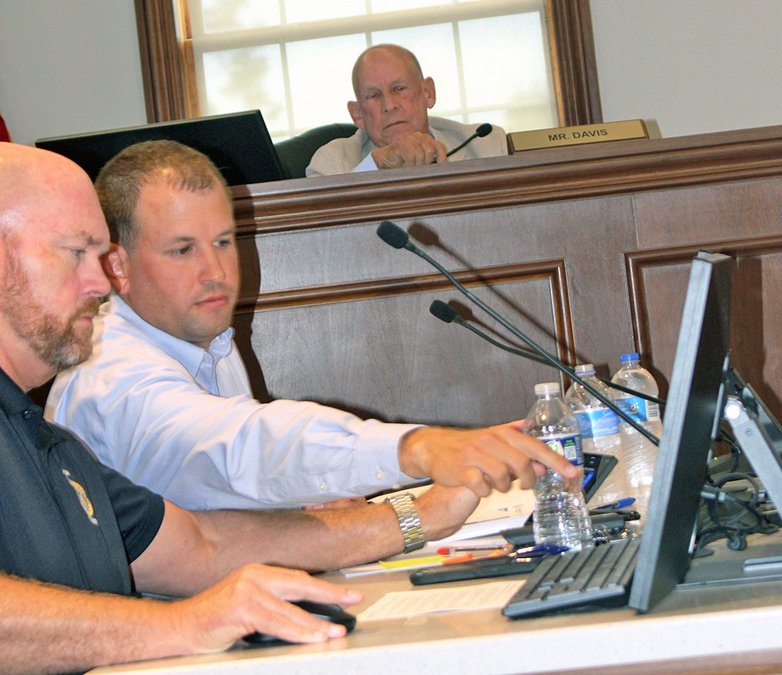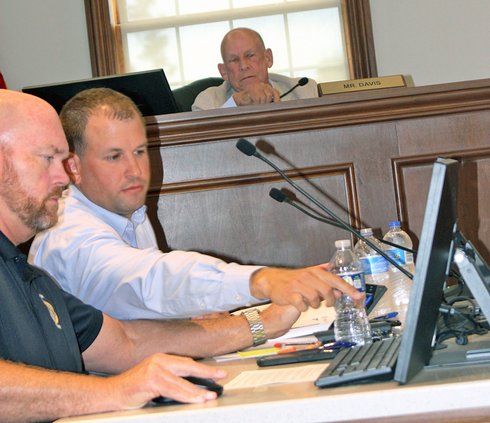

A recent report by the county's Planning and Development Director James Pope with commentary by Commissioner Ray Davis suggests that developers already have more than enough homes planned and "in the pipeline" to meet Bulloch County's alleged housing deficit — that is, based on raw numbers of housing units. The brief, informal report and summation during the Bulloch County Board of Commissioners regular meeting on Aug. 5 did not address housing types or affordability.
The Center for Economic Development Research, or CEDR, at the Georgia Institute of Technology completed the $200,000 study of regional housing needs and demand for Bryan, Bulloch, Effingham and Chatham counties in March. Localized findings were then presented at a joint, public meeting of Statesboro city government, Bulloch County government and Board of Education representatives held at Ogeechee Technical College in July.
That study indicated that Bulloch County faced an eight-year "housing deficit" of 7,815 home units, resulting in a "target" need of 977 newly built units each year on average. Researchers had considered both the "organic growth" in population already occurring in Bulloch and the other counties and a "Hyundai effect" projected as a result of the construction and opening of Hyundai Motor Group Metaplant America in northern Bryan County and of Hyundai's supplier manufacturers, including several now operating in Bulloch.
During the Aug. 5 meeting, citizens packed the commissioners' boardroom to its seating capacity over concerns about several zoning matters, especially changes from agricultural to residential uses. But before going into the particulars of the zoning requests, Pope asked for a moment to fulfill a request from commissioners. Chairman David Bennett told him to go ahead.
"As a result of the Georgia Tech housing study," Pope said, a few of the commissioners had asked him "to try to get an idea of what the housing numbers are in the pipeline for development."
Projects Pope considers to be in that figurative pipeline, he explained, include those beginning with a "sketch plan," which involves a formal approval by the county Planning and Zoning Commission, then those projects working their way through preliminary planning, and then a final plat for a subdivision, "which makes lots available for sale," then actual construction.
"Currently," or as of the first week of August, there were 1,820 lots approved in design, construction or ready for a building permit, and thus "likely to be permitted" over the next two to five years in the unincorporated parts of the county, Pope reported.
"Again, that's the number of lots that we would think in the next two to five years would likely build out," Pope said. "Obviously, the economy would have some impact on that if things slow down or whatnot."
Additionally, he counted 332 units as "under review" this month and next and another 724 units in proposed plans for which zoning has been approved since 2021 and so are "considered likely to develop in 2–5 years."
Adding the subtotals of those 1,820 permitted or likely to be permitted lots, the 332 "under review" units and the 724 "considered likely to develop," he arrived at a sum of 2,876 units "in the pipeline," for only the area outside the cities and towns and therefore under county zoning and development jurisdiction. He acknowledged that this was actually too precise, being "down to the lot number" when permits and plans "vary from day to day."
Statesboro's 5,000+
Looking beyond the county staff's jurisdiction to provide the commissioners' information on Bulloch County as a whole, Pope had also gathered the numbers reported by the cities of Statesboro and Brooklet. All of this was on an extended slide, scrolled down on the screens in the commissioners' boardroom.
Statesboro officials had provided counts of 1,256 housing units "under construction" as known from the issuance of land disturbing activity permits, another 1,909 actually going "vertical," in current construction, 305 more units "under review" and 1,727 with "zoning approved," for a total of 5,197 units "in pipeline" within the Statesboro city limits or pending annexations.
Brooklet's big prospect
Meanwhile, Brooklet is "in correspondence" for a state-recognized "Development of Regional Impact," or DRI, the proposed 728-unit Waterford Subdivision, Pope noted. On the Georgia Department of Community Affairs website for DRI applications, a form submitted July 1 by the Brooklet city clerk cites a $254.8 million estimated build-out value and $3 million estimated annual local tax revenue for this subdivision.
Adding the unincorporated county area's 2,876 units, Statesboro's 5,197 units and Brooklet's 728 potential units from that one large subdivision, Pope arrived at a total of 8,801 housing units in the "five-year Bulloch County pipeline" as shown in a summary square in the lower righthand corner of the single-page report. It was actually Commissioner Ray Davis, not Pope, who talked about that portion of it.
Ray Davis' commentary
"I asked James Pope and his staff that he would bring us up to date on the number of houses that were available in this county, and he did so," Davis said. "If you'll look at the bottom righthand corner, based on the Georgia Tech study … when you add up the number of houses, you have 8,801. Now, Mr. Pope's analyzation was over a five-year period. Georgia Tech's was over an eight-year period. Now, when you break that down, that's 977 houses per year. When you amortize it over five years, we've got 180% (of the) houses over the next five years that's needed, by the Georgia Tech study."
The corner summary on the slide showed the 7,815-unit "eight-year need" from the Georgia Tech study, as divided to 977 units per year and multiplied back to a five-year projection, for a 4,885-unit need over five years. The 8,801 units, if completed in five years, would exceed the annualized "need" by 80%.
Not all are houses
One fact missing from that summary and brief presentation was that not all of the planned or recently constructed housing "units" are actual single-family houses, or at least not in Statesboro. A significant fraction of the units that have been built are or currently "going vertical" in the city limits this year are apartments in complexes targeted to students, workers in need of "workforce housing" or senior citizens.
Another consideration, recognized in the Phase 1 study by the CEDR at Georgia Tech, is whether the homes being built are actually affordable to the people who need housing. Bulloch's median household income of $53,675 as of 2022 would put a $160,705 home in reach of the median-income household, according to the researchers, but the median price of a home sold in Bulloch County as of April 2024 was $307,700, and the average value of a home in Bulloch was $207,272 as determined by the county tax assessors. Now in the summer of 2025, the county government and school board in advertising tax increases are providing examples that apply the proposed millage rates to a $300,000 average market value for a homestead property.
Now the CEDR team is set to work on a Phase 2 housing study that involves the "outer ring" of counties — Candler, Evans, Screven, Tattnall, Long and Liberty — still in the one-hour drive time from the Hyundai plant, plus Bulloch County. Bulloch is the one county included in both phases.


